Location Choices for Dialysis Modality: Analysis and Discussion
VerifiedAdded on 2023/06/10
|11
|3417
|287
Essay
AI Summary
This essay delves into the critical decision of dialysis modality location, examining the preferences of patients with end-stage kidney disease. It highlights the increasing trend of dialysis in hospitals and satellite centers in Australia and New Zealand, while acknowledging the widespread preference for home-based dialysis due to its convenience and cost-effectiveness. The essay explores the advantages of home dialysis, including lower costs, improved patient outcomes like better cardiovascular health and dietary freedom, time savings, and a slower decline in residual kidney function. It also addresses the challenges of home dialysis, such as the need for patient or family support, potential technical complications, and comorbidities like type II diabetes. The essay concludes by emphasizing the need to align patient preferences with the realities of treatment locations, suggesting incentives, better patient education, and robust support systems to promote the sustainability and effectiveness of both home-based and facility dialysis. The importance of shared decision-making and remote patient monitoring is also discussed.
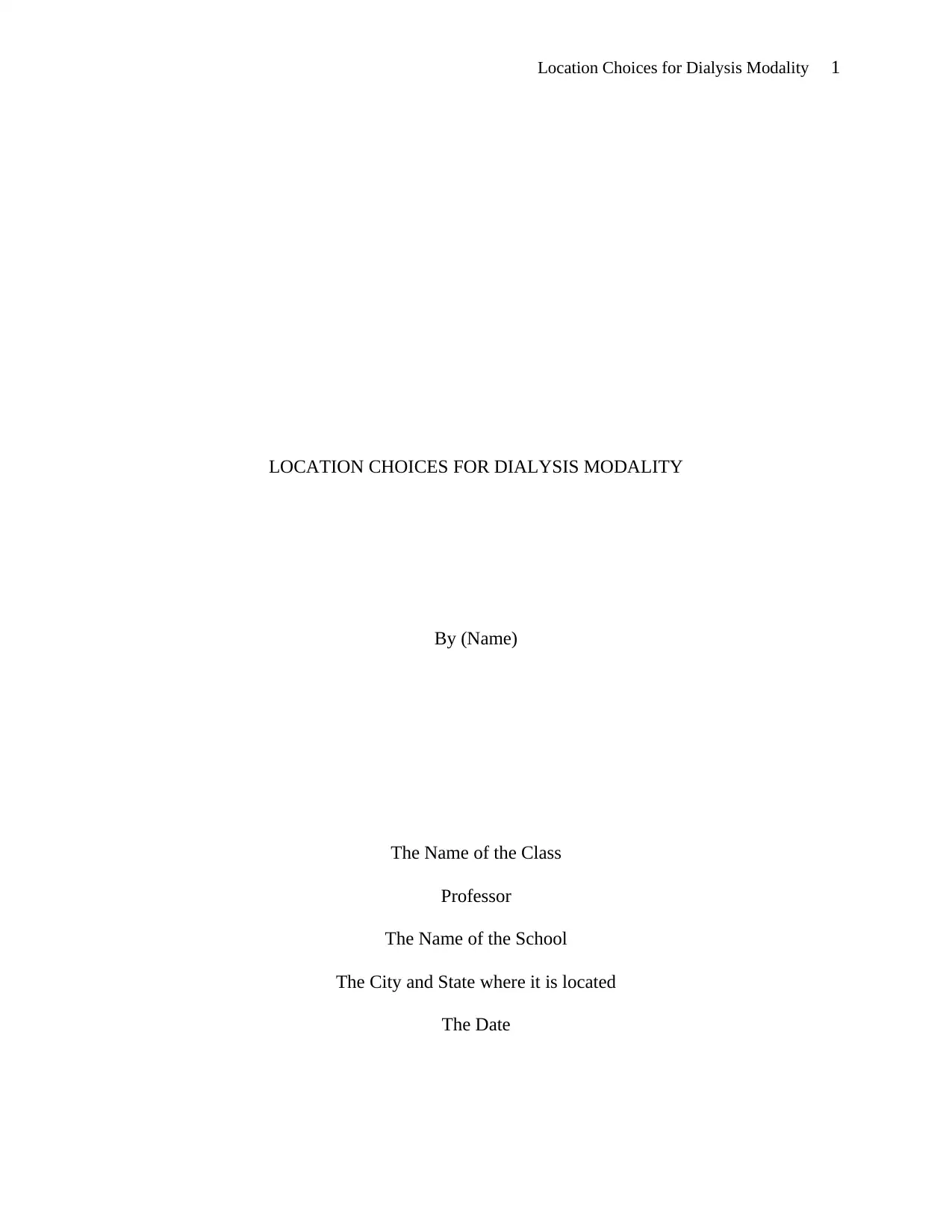
Location Choices for Dialysis Modality 1
LOCATION CHOICES FOR DIALYSIS MODALITY
By (Name)
The Name of the Class
Professor
The Name of the School
The City and State where it is located
The Date
LOCATION CHOICES FOR DIALYSIS MODALITY
By (Name)
The Name of the Class
Professor
The Name of the School
The City and State where it is located
The Date
Paraphrase This Document
Need a fresh take? Get an instant paraphrase of this document with our AI Paraphraser
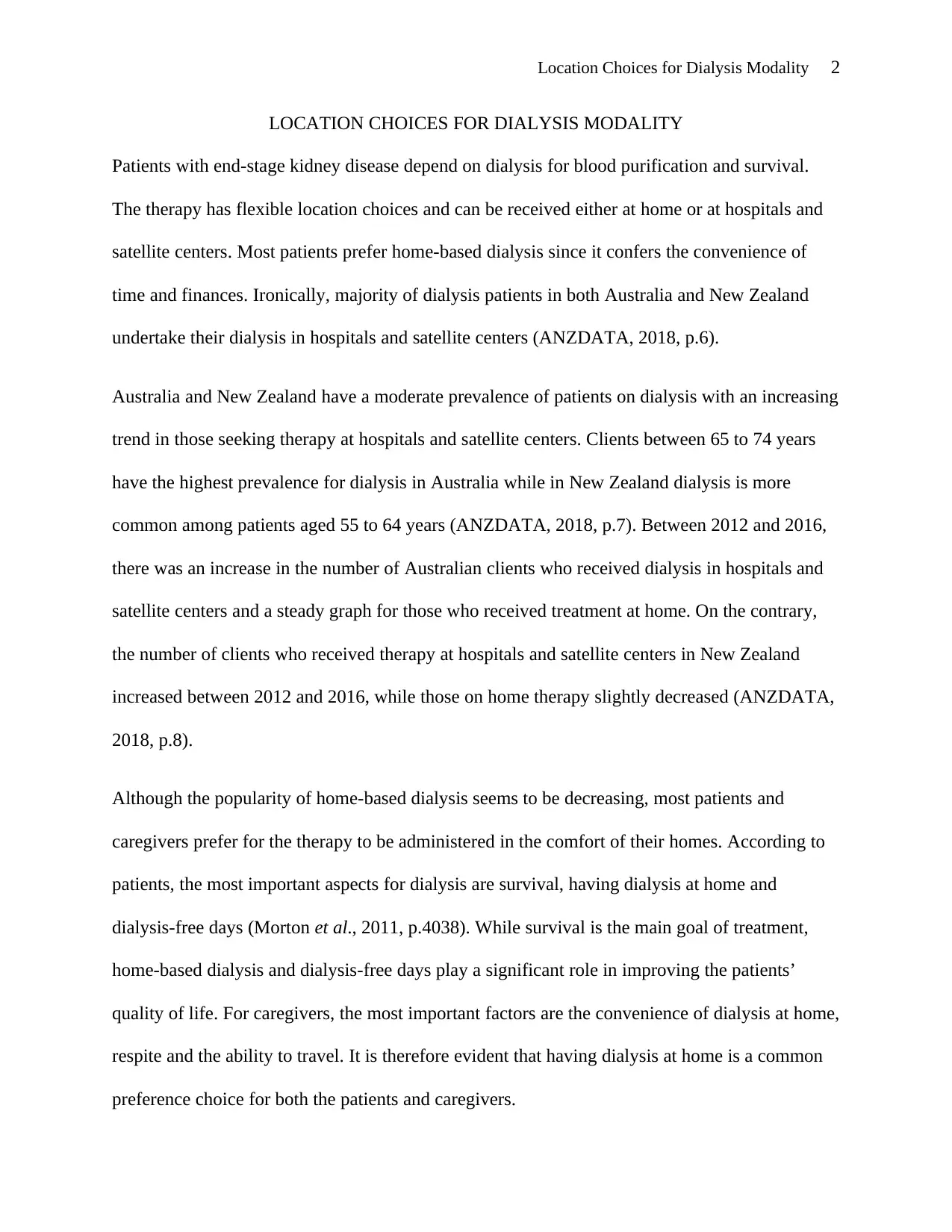
Location Choices for Dialysis Modality 2
LOCATION CHOICES FOR DIALYSIS MODALITY
Patients with end-stage kidney disease depend on dialysis for blood purification and survival.
The therapy has flexible location choices and can be received either at home or at hospitals and
satellite centers. Most patients prefer home-based dialysis since it confers the convenience of
time and finances. Ironically, majority of dialysis patients in both Australia and New Zealand
undertake their dialysis in hospitals and satellite centers (ANZDATA, 2018, p.6).
Australia and New Zealand have a moderate prevalence of patients on dialysis with an increasing
trend in those seeking therapy at hospitals and satellite centers. Clients between 65 to 74 years
have the highest prevalence for dialysis in Australia while in New Zealand dialysis is more
common among patients aged 55 to 64 years (ANZDATA, 2018, p.7). Between 2012 and 2016,
there was an increase in the number of Australian clients who received dialysis in hospitals and
satellite centers and a steady graph for those who received treatment at home. On the contrary,
the number of clients who received therapy at hospitals and satellite centers in New Zealand
increased between 2012 and 2016, while those on home therapy slightly decreased (ANZDATA,
2018, p.8).
Although the popularity of home-based dialysis seems to be decreasing, most patients and
caregivers prefer for the therapy to be administered in the comfort of their homes. According to
patients, the most important aspects for dialysis are survival, having dialysis at home and
dialysis-free days (Morton et al., 2011, p.4038). While survival is the main goal of treatment,
home-based dialysis and dialysis-free days play a significant role in improving the patients’
quality of life. For caregivers, the most important factors are the convenience of dialysis at home,
respite and the ability to travel. It is therefore evident that having dialysis at home is a common
preference choice for both the patients and caregivers.
LOCATION CHOICES FOR DIALYSIS MODALITY
Patients with end-stage kidney disease depend on dialysis for blood purification and survival.
The therapy has flexible location choices and can be received either at home or at hospitals and
satellite centers. Most patients prefer home-based dialysis since it confers the convenience of
time and finances. Ironically, majority of dialysis patients in both Australia and New Zealand
undertake their dialysis in hospitals and satellite centers (ANZDATA, 2018, p.6).
Australia and New Zealand have a moderate prevalence of patients on dialysis with an increasing
trend in those seeking therapy at hospitals and satellite centers. Clients between 65 to 74 years
have the highest prevalence for dialysis in Australia while in New Zealand dialysis is more
common among patients aged 55 to 64 years (ANZDATA, 2018, p.7). Between 2012 and 2016,
there was an increase in the number of Australian clients who received dialysis in hospitals and
satellite centers and a steady graph for those who received treatment at home. On the contrary,
the number of clients who received therapy at hospitals and satellite centers in New Zealand
increased between 2012 and 2016, while those on home therapy slightly decreased (ANZDATA,
2018, p.8).
Although the popularity of home-based dialysis seems to be decreasing, most patients and
caregivers prefer for the therapy to be administered in the comfort of their homes. According to
patients, the most important aspects for dialysis are survival, having dialysis at home and
dialysis-free days (Morton et al., 2011, p.4038). While survival is the main goal of treatment,
home-based dialysis and dialysis-free days play a significant role in improving the patients’
quality of life. For caregivers, the most important factors are the convenience of dialysis at home,
respite and the ability to travel. It is therefore evident that having dialysis at home is a common
preference choice for both the patients and caregivers.
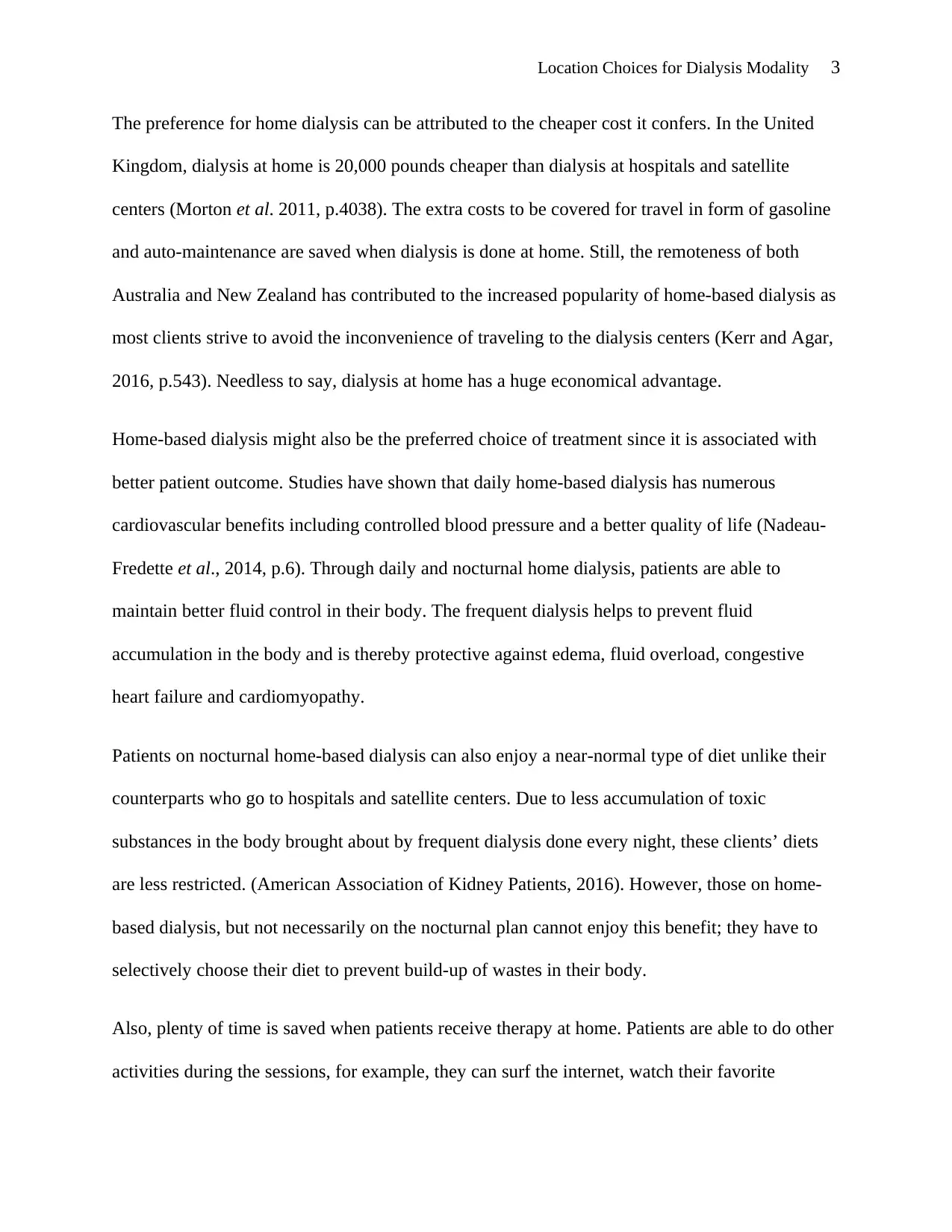
Location Choices for Dialysis Modality 3
The preference for home dialysis can be attributed to the cheaper cost it confers. In the United
Kingdom, dialysis at home is 20,000 pounds cheaper than dialysis at hospitals and satellite
centers (Morton et al. 2011, p.4038). The extra costs to be covered for travel in form of gasoline
and auto-maintenance are saved when dialysis is done at home. Still, the remoteness of both
Australia and New Zealand has contributed to the increased popularity of home-based dialysis as
most clients strive to avoid the inconvenience of traveling to the dialysis centers (Kerr and Agar,
2016, p.543). Needless to say, dialysis at home has a huge economical advantage.
Home-based dialysis might also be the preferred choice of treatment since it is associated with
better patient outcome. Studies have shown that daily home-based dialysis has numerous
cardiovascular benefits including controlled blood pressure and a better quality of life (Nadeau-
Fredette et al., 2014, p.6). Through daily and nocturnal home dialysis, patients are able to
maintain better fluid control in their body. The frequent dialysis helps to prevent fluid
accumulation in the body and is thereby protective against edema, fluid overload, congestive
heart failure and cardiomyopathy.
Patients on nocturnal home-based dialysis can also enjoy a near-normal type of diet unlike their
counterparts who go to hospitals and satellite centers. Due to less accumulation of toxic
substances in the body brought about by frequent dialysis done every night, these clients’ diets
are less restricted. (American Association of Kidney Patients, 2016). However, those on home-
based dialysis, but not necessarily on the nocturnal plan cannot enjoy this benefit; they have to
selectively choose their diet to prevent build-up of wastes in their body.
Also, plenty of time is saved when patients receive therapy at home. Patients are able to do other
activities during the sessions, for example, they can surf the internet, watch their favorite
The preference for home dialysis can be attributed to the cheaper cost it confers. In the United
Kingdom, dialysis at home is 20,000 pounds cheaper than dialysis at hospitals and satellite
centers (Morton et al. 2011, p.4038). The extra costs to be covered for travel in form of gasoline
and auto-maintenance are saved when dialysis is done at home. Still, the remoteness of both
Australia and New Zealand has contributed to the increased popularity of home-based dialysis as
most clients strive to avoid the inconvenience of traveling to the dialysis centers (Kerr and Agar,
2016, p.543). Needless to say, dialysis at home has a huge economical advantage.
Home-based dialysis might also be the preferred choice of treatment since it is associated with
better patient outcome. Studies have shown that daily home-based dialysis has numerous
cardiovascular benefits including controlled blood pressure and a better quality of life (Nadeau-
Fredette et al., 2014, p.6). Through daily and nocturnal home dialysis, patients are able to
maintain better fluid control in their body. The frequent dialysis helps to prevent fluid
accumulation in the body and is thereby protective against edema, fluid overload, congestive
heart failure and cardiomyopathy.
Patients on nocturnal home-based dialysis can also enjoy a near-normal type of diet unlike their
counterparts who go to hospitals and satellite centers. Due to less accumulation of toxic
substances in the body brought about by frequent dialysis done every night, these clients’ diets
are less restricted. (American Association of Kidney Patients, 2016). However, those on home-
based dialysis, but not necessarily on the nocturnal plan cannot enjoy this benefit; they have to
selectively choose their diet to prevent build-up of wastes in their body.
Also, plenty of time is saved when patients receive therapy at home. Patients are able to do other
activities during the sessions, for example, they can surf the internet, watch their favorite
⊘ This is a preview!⊘
Do you want full access?
Subscribe today to unlock all pages.

Trusted by 1+ million students worldwide
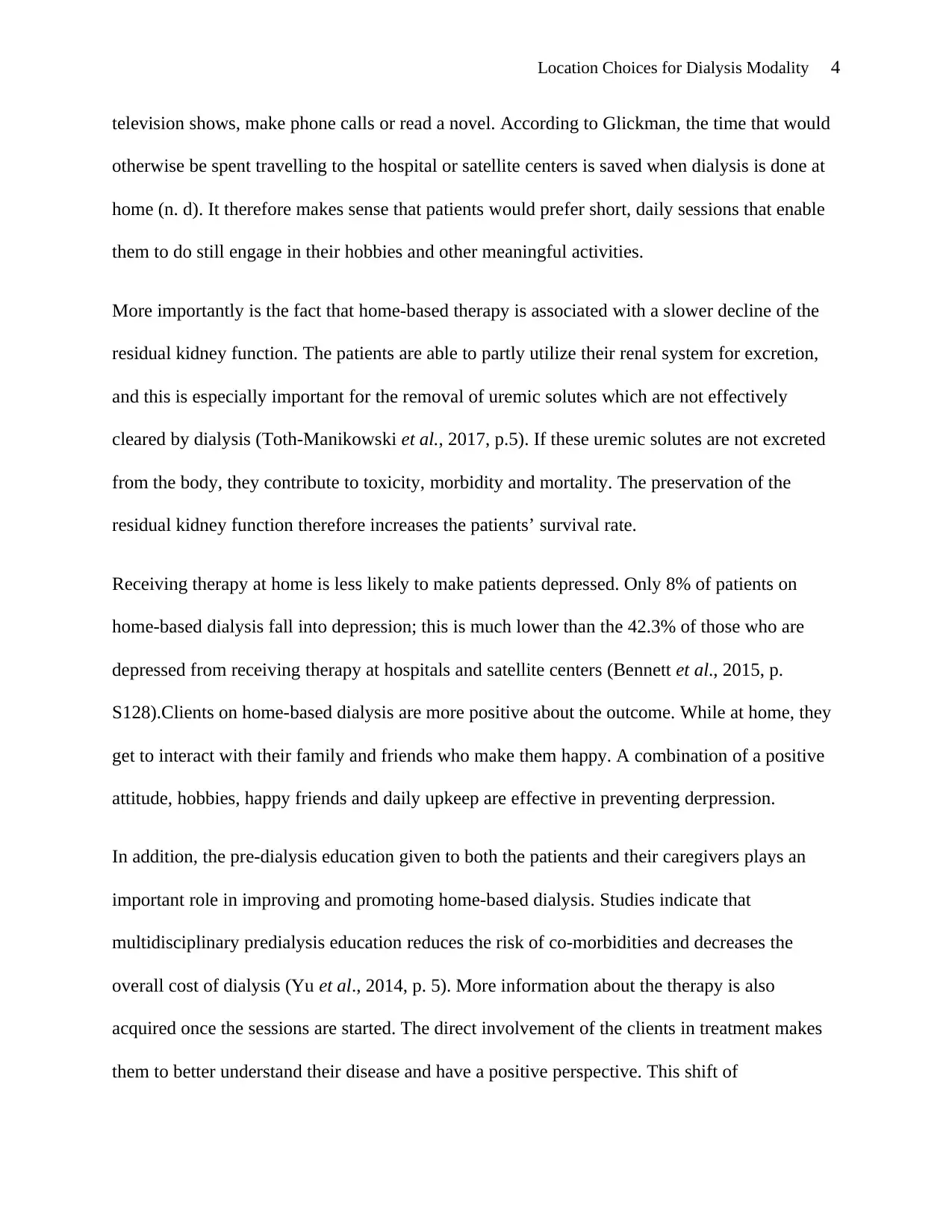
Location Choices for Dialysis Modality 4
television shows, make phone calls or read a novel. According to Glickman, the time that would
otherwise be spent travelling to the hospital or satellite centers is saved when dialysis is done at
home (n. d). It therefore makes sense that patients would prefer short, daily sessions that enable
them to do still engage in their hobbies and other meaningful activities.
More importantly is the fact that home-based therapy is associated with a slower decline of the
residual kidney function. The patients are able to partly utilize their renal system for excretion,
and this is especially important for the removal of uremic solutes which are not effectively
cleared by dialysis (Toth-Manikowski et al., 2017, p.5). If these uremic solutes are not excreted
from the body, they contribute to toxicity, morbidity and mortality. The preservation of the
residual kidney function therefore increases the patients’ survival rate.
Receiving therapy at home is less likely to make patients depressed. Only 8% of patients on
home-based dialysis fall into depression; this is much lower than the 42.3% of those who are
depressed from receiving therapy at hospitals and satellite centers (Bennett et al., 2015, p.
S128).Clients on home-based dialysis are more positive about the outcome. While at home, they
get to interact with their family and friends who make them happy. A combination of a positive
attitude, hobbies, happy friends and daily upkeep are effective in preventing derpression.
In addition, the pre-dialysis education given to both the patients and their caregivers plays an
important role in improving and promoting home-based dialysis. Studies indicate that
multidisciplinary predialysis education reduces the risk of co-morbidities and decreases the
overall cost of dialysis (Yu et al., 2014, p. 5). More information about the therapy is also
acquired once the sessions are started. The direct involvement of the clients in treatment makes
them to better understand their disease and have a positive perspective. This shift of
television shows, make phone calls or read a novel. According to Glickman, the time that would
otherwise be spent travelling to the hospital or satellite centers is saved when dialysis is done at
home (n. d). It therefore makes sense that patients would prefer short, daily sessions that enable
them to do still engage in their hobbies and other meaningful activities.
More importantly is the fact that home-based therapy is associated with a slower decline of the
residual kidney function. The patients are able to partly utilize their renal system for excretion,
and this is especially important for the removal of uremic solutes which are not effectively
cleared by dialysis (Toth-Manikowski et al., 2017, p.5). If these uremic solutes are not excreted
from the body, they contribute to toxicity, morbidity and mortality. The preservation of the
residual kidney function therefore increases the patients’ survival rate.
Receiving therapy at home is less likely to make patients depressed. Only 8% of patients on
home-based dialysis fall into depression; this is much lower than the 42.3% of those who are
depressed from receiving therapy at hospitals and satellite centers (Bennett et al., 2015, p.
S128).Clients on home-based dialysis are more positive about the outcome. While at home, they
get to interact with their family and friends who make them happy. A combination of a positive
attitude, hobbies, happy friends and daily upkeep are effective in preventing derpression.
In addition, the pre-dialysis education given to both the patients and their caregivers plays an
important role in improving and promoting home-based dialysis. Studies indicate that
multidisciplinary predialysis education reduces the risk of co-morbidities and decreases the
overall cost of dialysis (Yu et al., 2014, p. 5). More information about the therapy is also
acquired once the sessions are started. The direct involvement of the clients in treatment makes
them to better understand their disease and have a positive perspective. This shift of
Paraphrase This Document
Need a fresh take? Get an instant paraphrase of this document with our AI Paraphraser
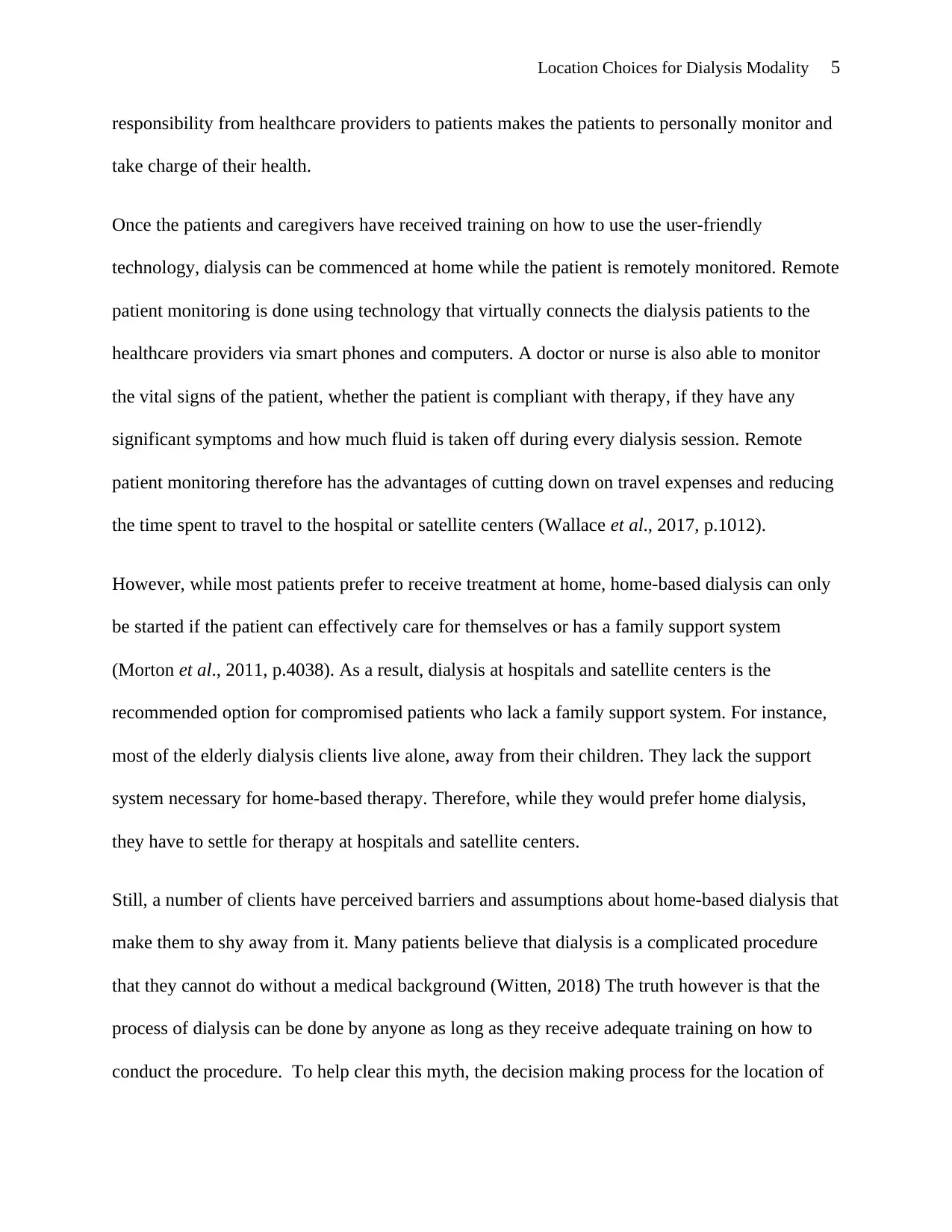
Location Choices for Dialysis Modality 5
responsibility from healthcare providers to patients makes the patients to personally monitor and
take charge of their health.
Once the patients and caregivers have received training on how to use the user-friendly
technology, dialysis can be commenced at home while the patient is remotely monitored. Remote
patient monitoring is done using technology that virtually connects the dialysis patients to the
healthcare providers via smart phones and computers. A doctor or nurse is also able to monitor
the vital signs of the patient, whether the patient is compliant with therapy, if they have any
significant symptoms and how much fluid is taken off during every dialysis session. Remote
patient monitoring therefore has the advantages of cutting down on travel expenses and reducing
the time spent to travel to the hospital or satellite centers (Wallace et al., 2017, p.1012).
However, while most patients prefer to receive treatment at home, home-based dialysis can only
be started if the patient can effectively care for themselves or has a family support system
(Morton et al., 2011, p.4038). As a result, dialysis at hospitals and satellite centers is the
recommended option for compromised patients who lack a family support system. For instance,
most of the elderly dialysis clients live alone, away from their children. They lack the support
system necessary for home-based therapy. Therefore, while they would prefer home dialysis,
they have to settle for therapy at hospitals and satellite centers.
Still, a number of clients have perceived barriers and assumptions about home-based dialysis that
make them to shy away from it. Many patients believe that dialysis is a complicated procedure
that they cannot do without a medical background (Witten, 2018) The truth however is that the
process of dialysis can be done by anyone as long as they receive adequate training on how to
conduct the procedure. To help clear this myth, the decision making process for the location of
responsibility from healthcare providers to patients makes the patients to personally monitor and
take charge of their health.
Once the patients and caregivers have received training on how to use the user-friendly
technology, dialysis can be commenced at home while the patient is remotely monitored. Remote
patient monitoring is done using technology that virtually connects the dialysis patients to the
healthcare providers via smart phones and computers. A doctor or nurse is also able to monitor
the vital signs of the patient, whether the patient is compliant with therapy, if they have any
significant symptoms and how much fluid is taken off during every dialysis session. Remote
patient monitoring therefore has the advantages of cutting down on travel expenses and reducing
the time spent to travel to the hospital or satellite centers (Wallace et al., 2017, p.1012).
However, while most patients prefer to receive treatment at home, home-based dialysis can only
be started if the patient can effectively care for themselves or has a family support system
(Morton et al., 2011, p.4038). As a result, dialysis at hospitals and satellite centers is the
recommended option for compromised patients who lack a family support system. For instance,
most of the elderly dialysis clients live alone, away from their children. They lack the support
system necessary for home-based therapy. Therefore, while they would prefer home dialysis,
they have to settle for therapy at hospitals and satellite centers.
Still, a number of clients have perceived barriers and assumptions about home-based dialysis that
make them to shy away from it. Many patients believe that dialysis is a complicated procedure
that they cannot do without a medical background (Witten, 2018) The truth however is that the
process of dialysis can be done by anyone as long as they receive adequate training on how to
conduct the procedure. To help clear this myth, the decision making process for the location of
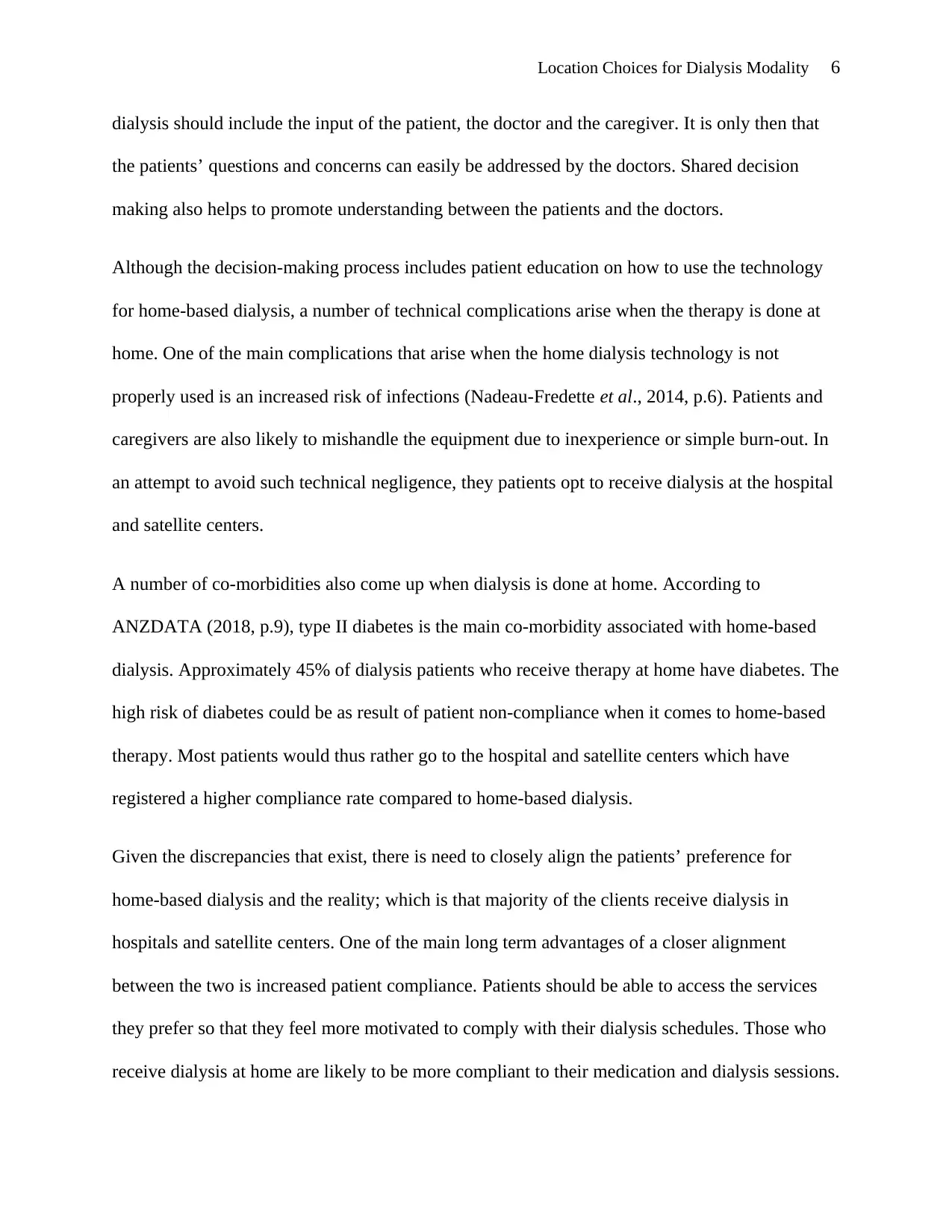
Location Choices for Dialysis Modality 6
dialysis should include the input of the patient, the doctor and the caregiver. It is only then that
the patients’ questions and concerns can easily be addressed by the doctors. Shared decision
making also helps to promote understanding between the patients and the doctors.
Although the decision-making process includes patient education on how to use the technology
for home-based dialysis, a number of technical complications arise when the therapy is done at
home. One of the main complications that arise when the home dialysis technology is not
properly used is an increased risk of infections (Nadeau-Fredette et al., 2014, p.6). Patients and
caregivers are also likely to mishandle the equipment due to inexperience or simple burn-out. In
an attempt to avoid such technical negligence, they patients opt to receive dialysis at the hospital
and satellite centers.
A number of co-morbidities also come up when dialysis is done at home. According to
ANZDATA (2018, p.9), type II diabetes is the main co-morbidity associated with home-based
dialysis. Approximately 45% of dialysis patients who receive therapy at home have diabetes. The
high risk of diabetes could be as result of patient non-compliance when it comes to home-based
therapy. Most patients would thus rather go to the hospital and satellite centers which have
registered a higher compliance rate compared to home-based dialysis.
Given the discrepancies that exist, there is need to closely align the patients’ preference for
home-based dialysis and the reality; which is that majority of the clients receive dialysis in
hospitals and satellite centers. One of the main long term advantages of a closer alignment
between the two is increased patient compliance. Patients should be able to access the services
they prefer so that they feel more motivated to comply with their dialysis schedules. Those who
receive dialysis at home are likely to be more compliant to their medication and dialysis sessions.
dialysis should include the input of the patient, the doctor and the caregiver. It is only then that
the patients’ questions and concerns can easily be addressed by the doctors. Shared decision
making also helps to promote understanding between the patients and the doctors.
Although the decision-making process includes patient education on how to use the technology
for home-based dialysis, a number of technical complications arise when the therapy is done at
home. One of the main complications that arise when the home dialysis technology is not
properly used is an increased risk of infections (Nadeau-Fredette et al., 2014, p.6). Patients and
caregivers are also likely to mishandle the equipment due to inexperience or simple burn-out. In
an attempt to avoid such technical negligence, they patients opt to receive dialysis at the hospital
and satellite centers.
A number of co-morbidities also come up when dialysis is done at home. According to
ANZDATA (2018, p.9), type II diabetes is the main co-morbidity associated with home-based
dialysis. Approximately 45% of dialysis patients who receive therapy at home have diabetes. The
high risk of diabetes could be as result of patient non-compliance when it comes to home-based
therapy. Most patients would thus rather go to the hospital and satellite centers which have
registered a higher compliance rate compared to home-based dialysis.
Given the discrepancies that exist, there is need to closely align the patients’ preference for
home-based dialysis and the reality; which is that majority of the clients receive dialysis in
hospitals and satellite centers. One of the main long term advantages of a closer alignment
between the two is increased patient compliance. Patients should be able to access the services
they prefer so that they feel more motivated to comply with their dialysis schedules. Those who
receive dialysis at home are likely to be more compliant to their medication and dialysis sessions.
⊘ This is a preview!⊘
Do you want full access?
Subscribe today to unlock all pages.

Trusted by 1+ million students worldwide
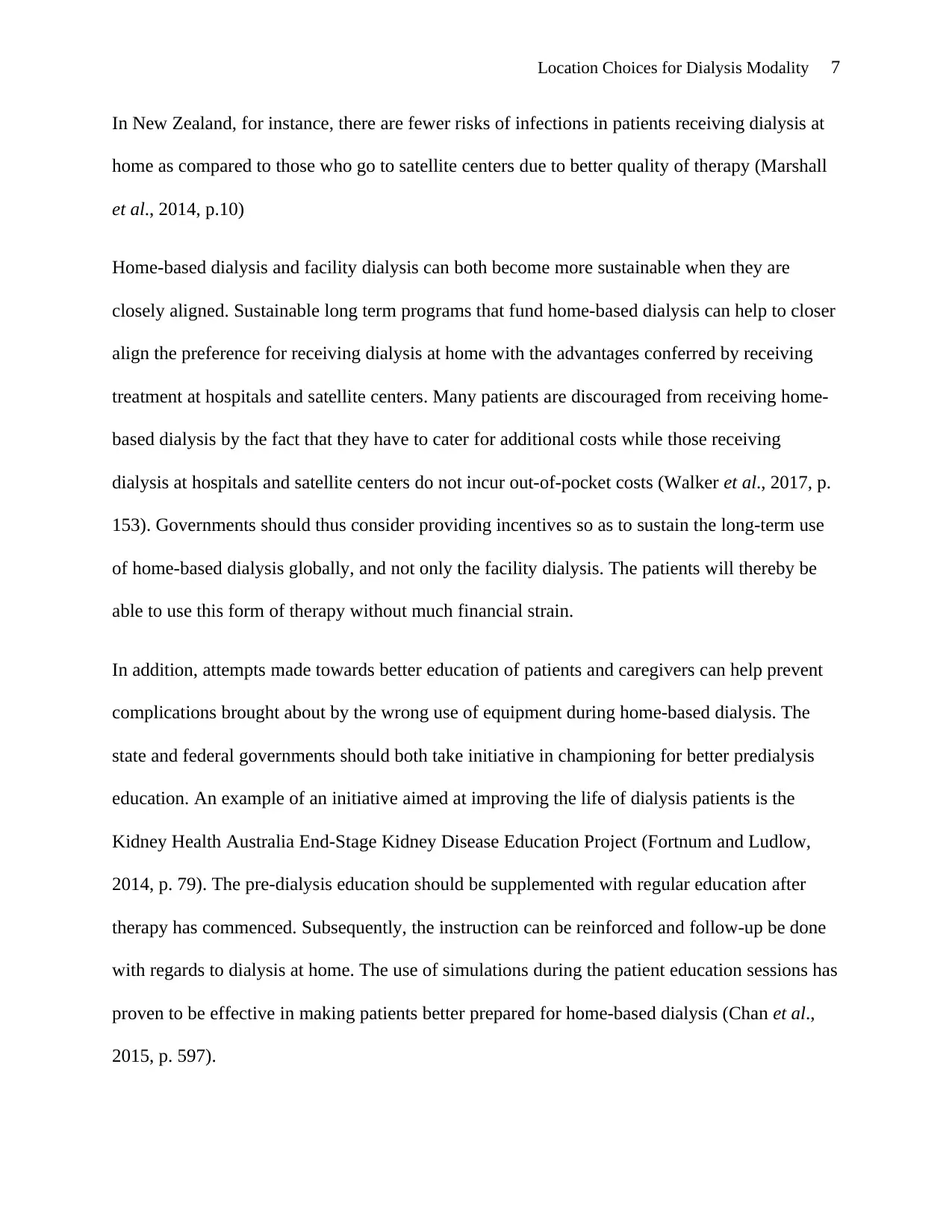
Location Choices for Dialysis Modality 7
In New Zealand, for instance, there are fewer risks of infections in patients receiving dialysis at
home as compared to those who go to satellite centers due to better quality of therapy (Marshall
et al., 2014, p.10)
Home-based dialysis and facility dialysis can both become more sustainable when they are
closely aligned. Sustainable long term programs that fund home-based dialysis can help to closer
align the preference for receiving dialysis at home with the advantages conferred by receiving
treatment at hospitals and satellite centers. Many patients are discouraged from receiving home-
based dialysis by the fact that they have to cater for additional costs while those receiving
dialysis at hospitals and satellite centers do not incur out-of-pocket costs (Walker et al., 2017, p.
153). Governments should thus consider providing incentives so as to sustain the long-term use
of home-based dialysis globally, and not only the facility dialysis. The patients will thereby be
able to use this form of therapy without much financial strain.
In addition, attempts made towards better education of patients and caregivers can help prevent
complications brought about by the wrong use of equipment during home-based dialysis. The
state and federal governments should both take initiative in championing for better predialysis
education. An example of an initiative aimed at improving the life of dialysis patients is the
Kidney Health Australia End-Stage Kidney Disease Education Project (Fortnum and Ludlow,
2014, p. 79). The pre-dialysis education should be supplemented with regular education after
therapy has commenced. Subsequently, the instruction can be reinforced and follow-up be done
with regards to dialysis at home. The use of simulations during the patient education sessions has
proven to be effective in making patients better prepared for home-based dialysis (Chan et al.,
2015, p. 597).
In New Zealand, for instance, there are fewer risks of infections in patients receiving dialysis at
home as compared to those who go to satellite centers due to better quality of therapy (Marshall
et al., 2014, p.10)
Home-based dialysis and facility dialysis can both become more sustainable when they are
closely aligned. Sustainable long term programs that fund home-based dialysis can help to closer
align the preference for receiving dialysis at home with the advantages conferred by receiving
treatment at hospitals and satellite centers. Many patients are discouraged from receiving home-
based dialysis by the fact that they have to cater for additional costs while those receiving
dialysis at hospitals and satellite centers do not incur out-of-pocket costs (Walker et al., 2017, p.
153). Governments should thus consider providing incentives so as to sustain the long-term use
of home-based dialysis globally, and not only the facility dialysis. The patients will thereby be
able to use this form of therapy without much financial strain.
In addition, attempts made towards better education of patients and caregivers can help prevent
complications brought about by the wrong use of equipment during home-based dialysis. The
state and federal governments should both take initiative in championing for better predialysis
education. An example of an initiative aimed at improving the life of dialysis patients is the
Kidney Health Australia End-Stage Kidney Disease Education Project (Fortnum and Ludlow,
2014, p. 79). The pre-dialysis education should be supplemented with regular education after
therapy has commenced. Subsequently, the instruction can be reinforced and follow-up be done
with regards to dialysis at home. The use of simulations during the patient education sessions has
proven to be effective in making patients better prepared for home-based dialysis (Chan et al.,
2015, p. 597).
Paraphrase This Document
Need a fresh take? Get an instant paraphrase of this document with our AI Paraphraser
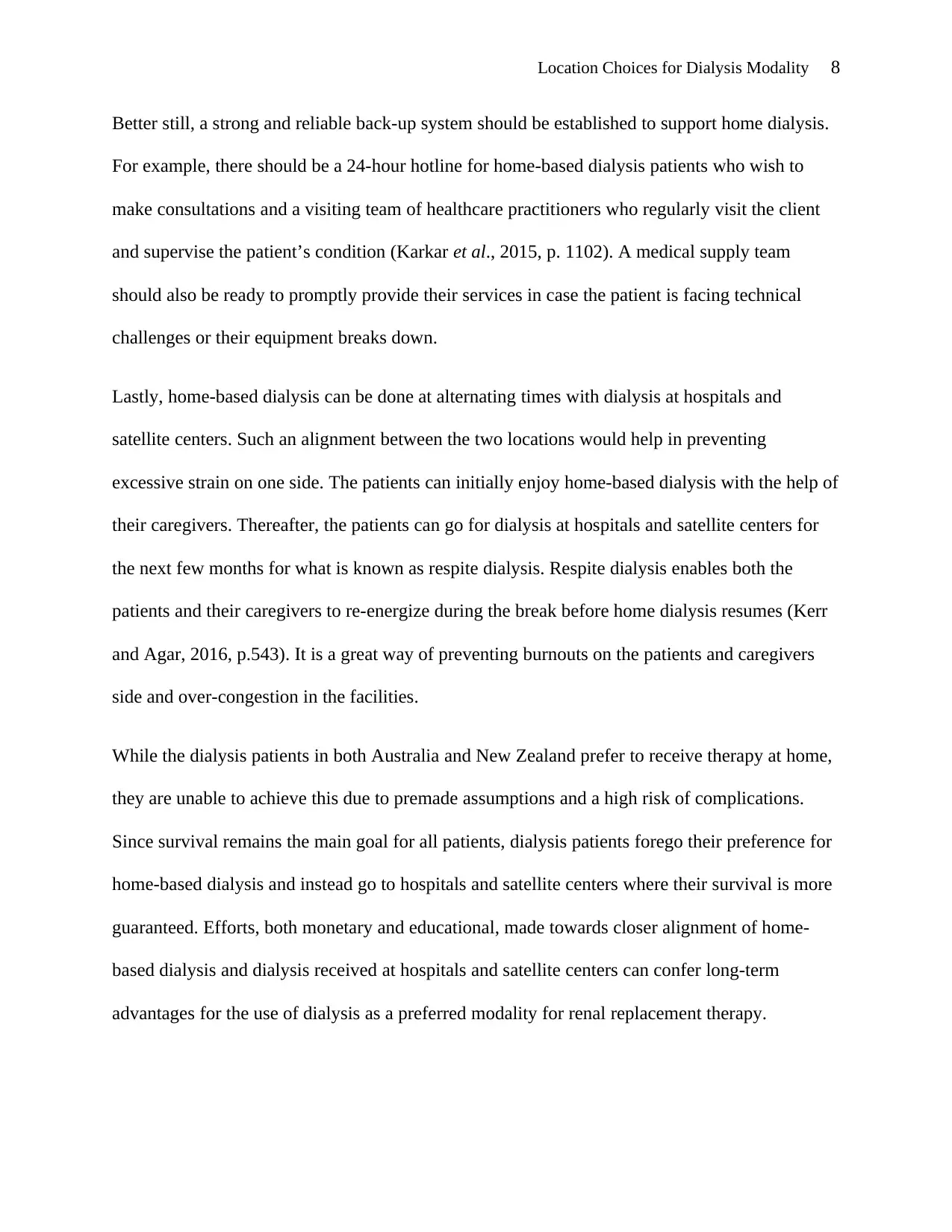
Location Choices for Dialysis Modality 8
Better still, a strong and reliable back-up system should be established to support home dialysis.
For example, there should be a 24-hour hotline for home-based dialysis patients who wish to
make consultations and a visiting team of healthcare practitioners who regularly visit the client
and supervise the patient’s condition (Karkar et al., 2015, p. 1102). A medical supply team
should also be ready to promptly provide their services in case the patient is facing technical
challenges or their equipment breaks down.
Lastly, home-based dialysis can be done at alternating times with dialysis at hospitals and
satellite centers. Such an alignment between the two locations would help in preventing
excessive strain on one side. The patients can initially enjoy home-based dialysis with the help of
their caregivers. Thereafter, the patients can go for dialysis at hospitals and satellite centers for
the next few months for what is known as respite dialysis. Respite dialysis enables both the
patients and their caregivers to re-energize during the break before home dialysis resumes (Kerr
and Agar, 2016, p.543). It is a great way of preventing burnouts on the patients and caregivers
side and over-congestion in the facilities.
While the dialysis patients in both Australia and New Zealand prefer to receive therapy at home,
they are unable to achieve this due to premade assumptions and a high risk of complications.
Since survival remains the main goal for all patients, dialysis patients forego their preference for
home-based dialysis and instead go to hospitals and satellite centers where their survival is more
guaranteed. Efforts, both monetary and educational, made towards closer alignment of home-
based dialysis and dialysis received at hospitals and satellite centers can confer long-term
advantages for the use of dialysis as a preferred modality for renal replacement therapy.
Better still, a strong and reliable back-up system should be established to support home dialysis.
For example, there should be a 24-hour hotline for home-based dialysis patients who wish to
make consultations and a visiting team of healthcare practitioners who regularly visit the client
and supervise the patient’s condition (Karkar et al., 2015, p. 1102). A medical supply team
should also be ready to promptly provide their services in case the patient is facing technical
challenges or their equipment breaks down.
Lastly, home-based dialysis can be done at alternating times with dialysis at hospitals and
satellite centers. Such an alignment between the two locations would help in preventing
excessive strain on one side. The patients can initially enjoy home-based dialysis with the help of
their caregivers. Thereafter, the patients can go for dialysis at hospitals and satellite centers for
the next few months for what is known as respite dialysis. Respite dialysis enables both the
patients and their caregivers to re-energize during the break before home dialysis resumes (Kerr
and Agar, 2016, p.543). It is a great way of preventing burnouts on the patients and caregivers
side and over-congestion in the facilities.
While the dialysis patients in both Australia and New Zealand prefer to receive therapy at home,
they are unable to achieve this due to premade assumptions and a high risk of complications.
Since survival remains the main goal for all patients, dialysis patients forego their preference for
home-based dialysis and instead go to hospitals and satellite centers where their survival is more
guaranteed. Efforts, both monetary and educational, made towards closer alignment of home-
based dialysis and dialysis received at hospitals and satellite centers can confer long-term
advantages for the use of dialysis as a preferred modality for renal replacement therapy.
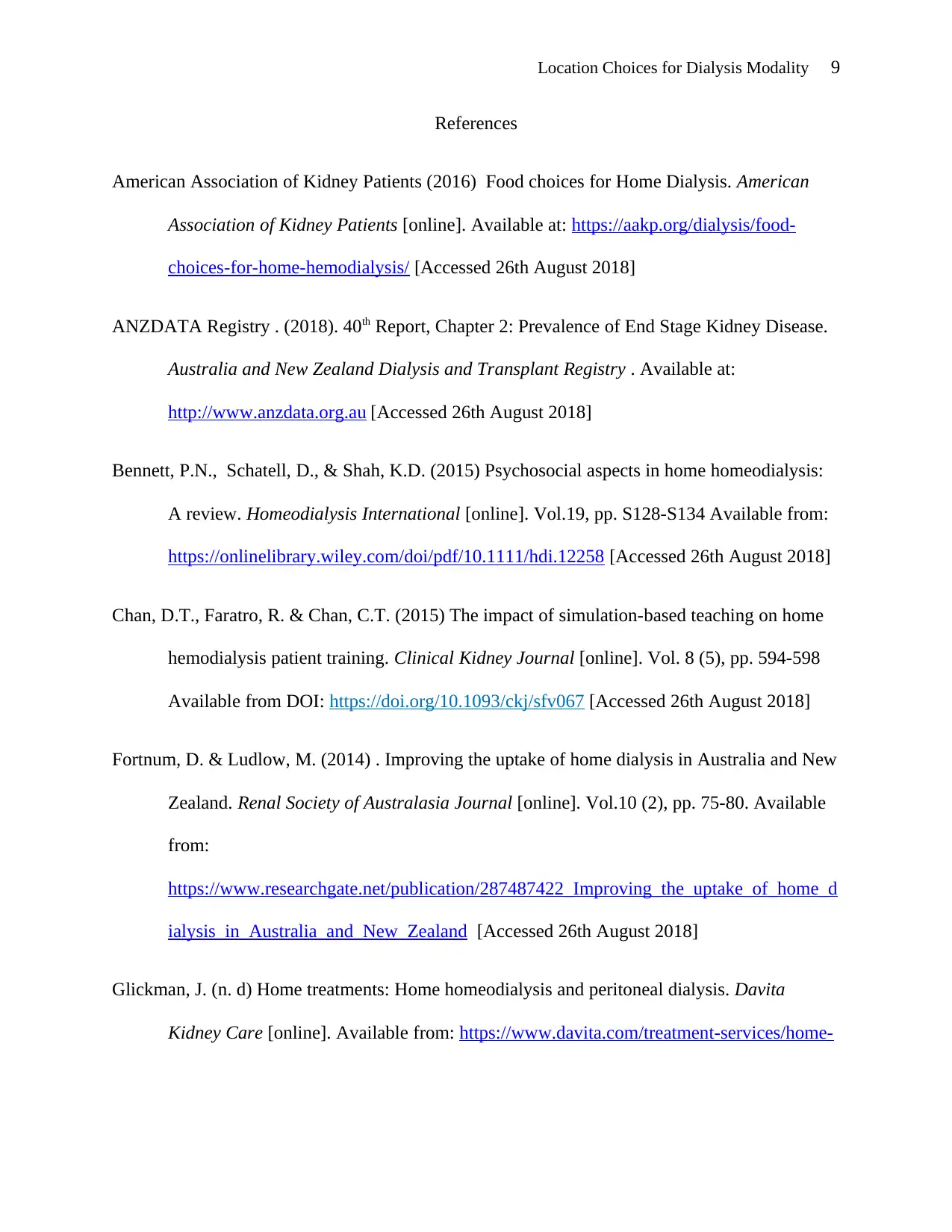
Location Choices for Dialysis Modality 9
References
American Association of Kidney Patients (2016) Food choices for Home Dialysis. American
Association of Kidney Patients [online]. Available at: https://aakp.org/dialysis/food-
choices-for-home-hemodialysis/ [Accessed 26th August 2018]
ANZDATA Registry . (2018). 40th Report, Chapter 2: Prevalence of End Stage Kidney Disease.
Australia and New Zealand Dialysis and Transplant Registry . Available at:
http://www.anzdata.org.au [Accessed 26th August 2018]
Bennett, P.N., Schatell, D., & Shah, K.D. (2015) Psychosocial aspects in home homeodialysis:
A review. Homeodialysis International [online]. Vol.19, pp. S128-S134 Available from:
https://onlinelibrary.wiley.com/doi/pdf/10.1111/hdi.12258 [Accessed 26th August 2018]
Chan, D.T., Faratro, R. & Chan, C.T. (2015) The impact of simulation-based teaching on home
hemodialysis patient training. Clinical Kidney Journal [online]. Vol. 8 (5), pp. 594-598
Available from DOI: https://doi.org/10.1093/ckj/sfv067 [Accessed 26th August 2018]
Fortnum, D. & Ludlow, M. (2014) . Improving the uptake of home dialysis in Australia and New
Zealand. Renal Society of Australasia Journal [online]. Vol.10 (2), pp. 75-80. Available
from:
https://www.researchgate.net/publication/287487422_Improving_the_uptake_of_home_d
ialysis_in_Australia_and_New_Zealand [Accessed 26th August 2018]
Glickman, J. (n. d) Home treatments: Home homeodialysis and peritoneal dialysis. Davita
Kidney Care [online]. Available from: https://www.davita.com/treatment-services/home-
References
American Association of Kidney Patients (2016) Food choices for Home Dialysis. American
Association of Kidney Patients [online]. Available at: https://aakp.org/dialysis/food-
choices-for-home-hemodialysis/ [Accessed 26th August 2018]
ANZDATA Registry . (2018). 40th Report, Chapter 2: Prevalence of End Stage Kidney Disease.
Australia and New Zealand Dialysis and Transplant Registry . Available at:
http://www.anzdata.org.au [Accessed 26th August 2018]
Bennett, P.N., Schatell, D., & Shah, K.D. (2015) Psychosocial aspects in home homeodialysis:
A review. Homeodialysis International [online]. Vol.19, pp. S128-S134 Available from:
https://onlinelibrary.wiley.com/doi/pdf/10.1111/hdi.12258 [Accessed 26th August 2018]
Chan, D.T., Faratro, R. & Chan, C.T. (2015) The impact of simulation-based teaching on home
hemodialysis patient training. Clinical Kidney Journal [online]. Vol. 8 (5), pp. 594-598
Available from DOI: https://doi.org/10.1093/ckj/sfv067 [Accessed 26th August 2018]
Fortnum, D. & Ludlow, M. (2014) . Improving the uptake of home dialysis in Australia and New
Zealand. Renal Society of Australasia Journal [online]. Vol.10 (2), pp. 75-80. Available
from:
https://www.researchgate.net/publication/287487422_Improving_the_uptake_of_home_d
ialysis_in_Australia_and_New_Zealand [Accessed 26th August 2018]
Glickman, J. (n. d) Home treatments: Home homeodialysis and peritoneal dialysis. Davita
Kidney Care [online]. Available from: https://www.davita.com/treatment-services/home-
⊘ This is a preview!⊘
Do you want full access?
Subscribe today to unlock all pages.

Trusted by 1+ million students worldwide
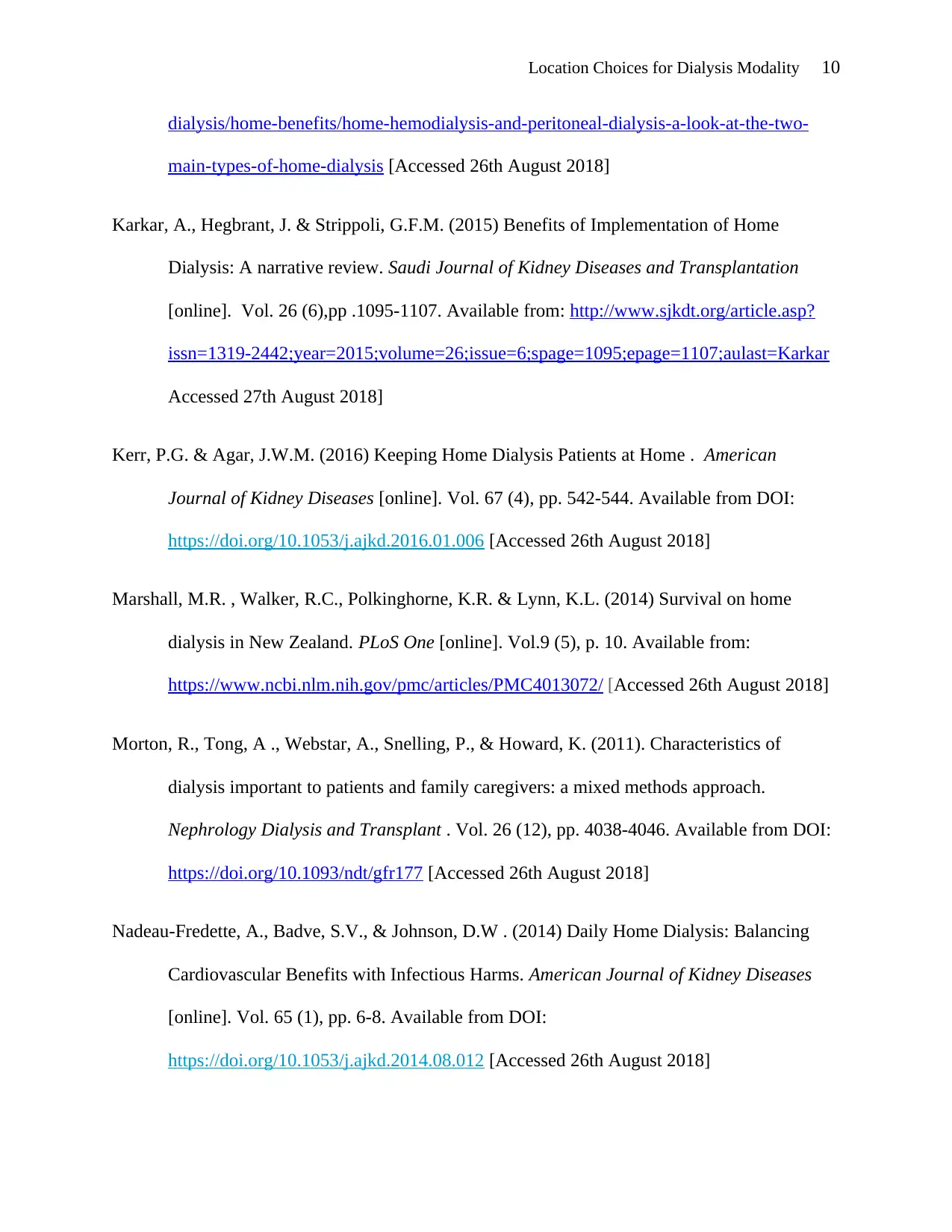
Location Choices for Dialysis Modality 10
dialysis/home-benefits/home-hemodialysis-and-peritoneal-dialysis-a-look-at-the-two-
main-types-of-home-dialysis [Accessed 26th August 2018]
Karkar, A., Hegbrant, J. & Strippoli, G.F.M. (2015) Benefits of Implementation of Home
Dialysis: A narrative review. Saudi Journal of Kidney Diseases and Transplantation
[online]. Vol. 26 (6),pp .1095-1107. Available from: http://www.sjkdt.org/article.asp?
issn=1319-2442;year=2015;volume=26;issue=6;spage=1095;epage=1107;aulast=Karkar
Accessed 27th August 2018]
Kerr, P.G. & Agar, J.W.M. (2016) Keeping Home Dialysis Patients at Home . American
Journal of Kidney Diseases [online]. Vol. 67 (4), pp. 542-544. Available from DOI:
https://doi.org/10.1053/j.ajkd.2016.01.006 [Accessed 26th August 2018]
Marshall, M.R. , Walker, R.C., Polkinghorne, K.R. & Lynn, K.L. (2014) Survival on home
dialysis in New Zealand. PLoS One [online]. Vol.9 (5), p. 10. Available from:
https://www.ncbi.nlm.nih.gov/pmc/articles/PMC4013072/ [Accessed 26th August 2018]
Morton, R., Tong, A ., Webstar, A., Snelling, P., & Howard, K. (2011). Characteristics of
dialysis important to patients and family caregivers: a mixed methods approach.
Nephrology Dialysis and Transplant . Vol. 26 (12), pp. 4038-4046. Available from DOI:
https://doi.org/10.1093/ndt/gfr177 [Accessed 26th August 2018]
Nadeau-Fredette, A., Badve, S.V., & Johnson, D.W . (2014) Daily Home Dialysis: Balancing
Cardiovascular Benefits with Infectious Harms. American Journal of Kidney Diseases
[online]. Vol. 65 (1), pp. 6-8. Available from DOI:
https://doi.org/10.1053/j.ajkd.2014.08.012 [Accessed 26th August 2018]
dialysis/home-benefits/home-hemodialysis-and-peritoneal-dialysis-a-look-at-the-two-
main-types-of-home-dialysis [Accessed 26th August 2018]
Karkar, A., Hegbrant, J. & Strippoli, G.F.M. (2015) Benefits of Implementation of Home
Dialysis: A narrative review. Saudi Journal of Kidney Diseases and Transplantation
[online]. Vol. 26 (6),pp .1095-1107. Available from: http://www.sjkdt.org/article.asp?
issn=1319-2442;year=2015;volume=26;issue=6;spage=1095;epage=1107;aulast=Karkar
Accessed 27th August 2018]
Kerr, P.G. & Agar, J.W.M. (2016) Keeping Home Dialysis Patients at Home . American
Journal of Kidney Diseases [online]. Vol. 67 (4), pp. 542-544. Available from DOI:
https://doi.org/10.1053/j.ajkd.2016.01.006 [Accessed 26th August 2018]
Marshall, M.R. , Walker, R.C., Polkinghorne, K.R. & Lynn, K.L. (2014) Survival on home
dialysis in New Zealand. PLoS One [online]. Vol.9 (5), p. 10. Available from:
https://www.ncbi.nlm.nih.gov/pmc/articles/PMC4013072/ [Accessed 26th August 2018]
Morton, R., Tong, A ., Webstar, A., Snelling, P., & Howard, K. (2011). Characteristics of
dialysis important to patients and family caregivers: a mixed methods approach.
Nephrology Dialysis and Transplant . Vol. 26 (12), pp. 4038-4046. Available from DOI:
https://doi.org/10.1093/ndt/gfr177 [Accessed 26th August 2018]
Nadeau-Fredette, A., Badve, S.V., & Johnson, D.W . (2014) Daily Home Dialysis: Balancing
Cardiovascular Benefits with Infectious Harms. American Journal of Kidney Diseases
[online]. Vol. 65 (1), pp. 6-8. Available from DOI:
https://doi.org/10.1053/j.ajkd.2014.08.012 [Accessed 26th August 2018]
Paraphrase This Document
Need a fresh take? Get an instant paraphrase of this document with our AI Paraphraser
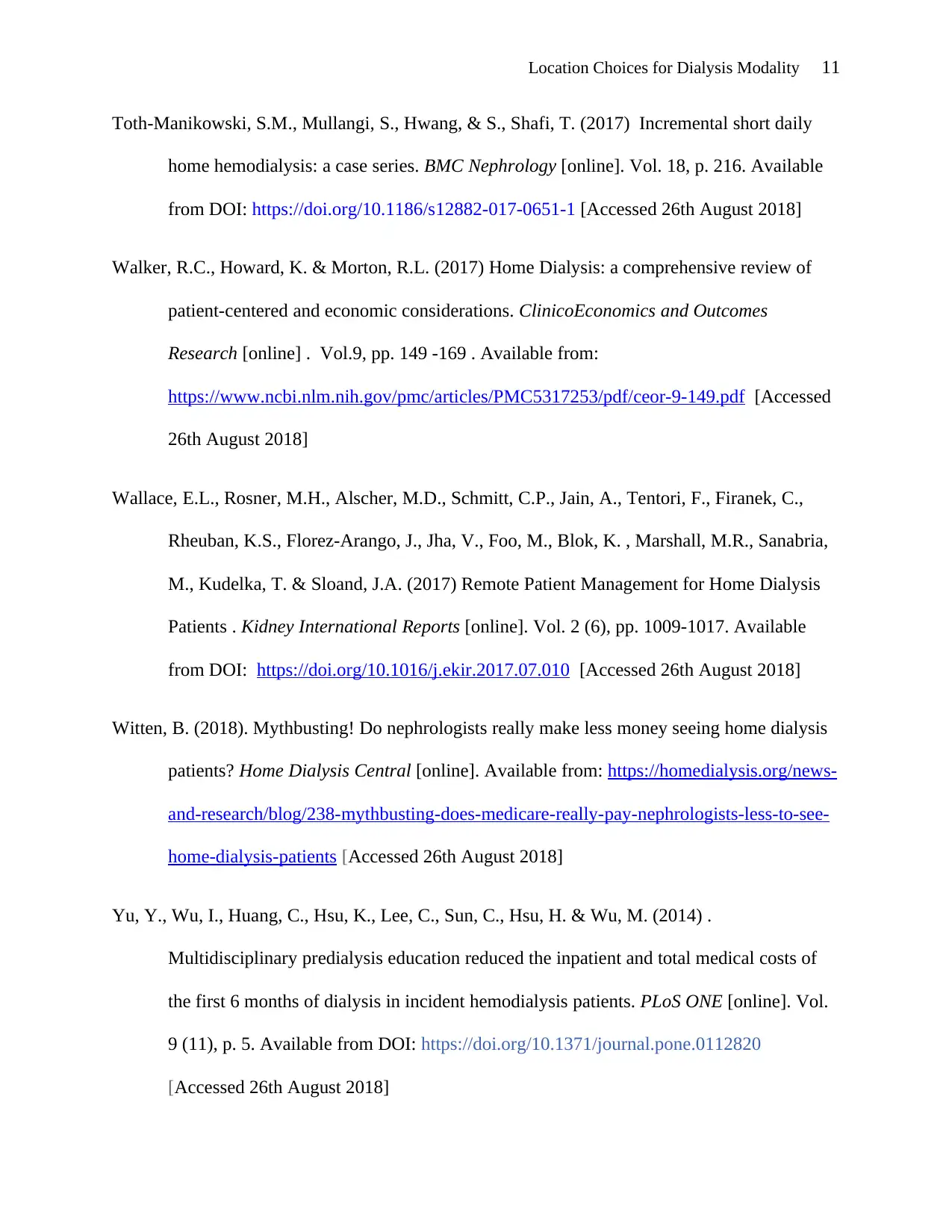
Location Choices for Dialysis Modality 11
Toth-Manikowski, S.M., Mullangi, S., Hwang, & S., Shafi, T. (2017) Incremental short daily
home hemodialysis: a case series. BMC Nephrology [online]. Vol. 18, p. 216. Available
from DOI: https://doi.org/10.1186/s12882-017-0651-1 [Accessed 26th August 2018]
Walker, R.C., Howard, K. & Morton, R.L. (2017) Home Dialysis: a comprehensive review of
patient-centered and economic considerations. ClinicoEconomics and Outcomes
Research [online] . Vol.9, pp. 149 -169 . Available from:
https://www.ncbi.nlm.nih.gov/pmc/articles/PMC5317253/pdf/ceor-9-149.pdf [Accessed
26th August 2018]
Wallace, E.L., Rosner, M.H., Alscher, M.D., Schmitt, C.P., Jain, A., Tentori, F., Firanek, C.,
Rheuban, K.S., Florez-Arango, J., Jha, V., Foo, M., Blok, K. , Marshall, M.R., Sanabria,
M., Kudelka, T. & Sloand, J.A. (2017) Remote Patient Management for Home Dialysis
Patients . Kidney International Reports [online]. Vol. 2 (6), pp. 1009-1017. Available
from DOI: https://doi.org/10.1016/j.ekir.2017.07.010 [Accessed 26th August 2018]
Witten, B. (2018). Mythbusting! Do nephrologists really make less money seeing home dialysis
patients? Home Dialysis Central [online]. Available from: https://homedialysis.org/news-
and-research/blog/238-mythbusting-does-medicare-really-pay-nephrologists-less-to-see-
home-dialysis-patients [Accessed 26th August 2018]
Yu, Y., Wu, I., Huang, C., Hsu, K., Lee, C., Sun, C., Hsu, H. & Wu, M. (2014) .
Multidisciplinary predialysis education reduced the inpatient and total medical costs of
the first 6 months of dialysis in incident hemodialysis patients. PLoS ONE [online]. Vol.
9 (11), p. 5. Available from DOI: https://doi.org/10.1371/journal.pone.0112820
[Accessed 26th August 2018]
Toth-Manikowski, S.M., Mullangi, S., Hwang, & S., Shafi, T. (2017) Incremental short daily
home hemodialysis: a case series. BMC Nephrology [online]. Vol. 18, p. 216. Available
from DOI: https://doi.org/10.1186/s12882-017-0651-1 [Accessed 26th August 2018]
Walker, R.C., Howard, K. & Morton, R.L. (2017) Home Dialysis: a comprehensive review of
patient-centered and economic considerations. ClinicoEconomics and Outcomes
Research [online] . Vol.9, pp. 149 -169 . Available from:
https://www.ncbi.nlm.nih.gov/pmc/articles/PMC5317253/pdf/ceor-9-149.pdf [Accessed
26th August 2018]
Wallace, E.L., Rosner, M.H., Alscher, M.D., Schmitt, C.P., Jain, A., Tentori, F., Firanek, C.,
Rheuban, K.S., Florez-Arango, J., Jha, V., Foo, M., Blok, K. , Marshall, M.R., Sanabria,
M., Kudelka, T. & Sloand, J.A. (2017) Remote Patient Management for Home Dialysis
Patients . Kidney International Reports [online]. Vol. 2 (6), pp. 1009-1017. Available
from DOI: https://doi.org/10.1016/j.ekir.2017.07.010 [Accessed 26th August 2018]
Witten, B. (2018). Mythbusting! Do nephrologists really make less money seeing home dialysis
patients? Home Dialysis Central [online]. Available from: https://homedialysis.org/news-
and-research/blog/238-mythbusting-does-medicare-really-pay-nephrologists-less-to-see-
home-dialysis-patients [Accessed 26th August 2018]
Yu, Y., Wu, I., Huang, C., Hsu, K., Lee, C., Sun, C., Hsu, H. & Wu, M. (2014) .
Multidisciplinary predialysis education reduced the inpatient and total medical costs of
the first 6 months of dialysis in incident hemodialysis patients. PLoS ONE [online]. Vol.
9 (11), p. 5. Available from DOI: https://doi.org/10.1371/journal.pone.0112820
[Accessed 26th August 2018]
1 out of 11
Your All-in-One AI-Powered Toolkit for Academic Success.
+13062052269
info@desklib.com
Available 24*7 on WhatsApp / Email
![[object Object]](/_next/static/media/star-bottom.7253800d.svg)
Unlock your academic potential
Copyright © 2020–2025 A2Z Services. All Rights Reserved. Developed and managed by ZUCOL.

